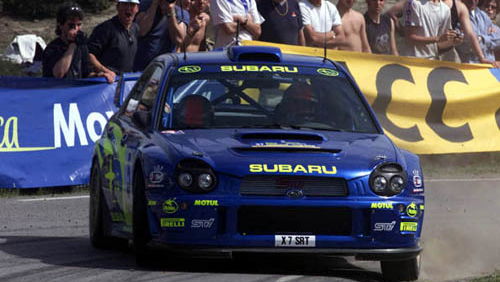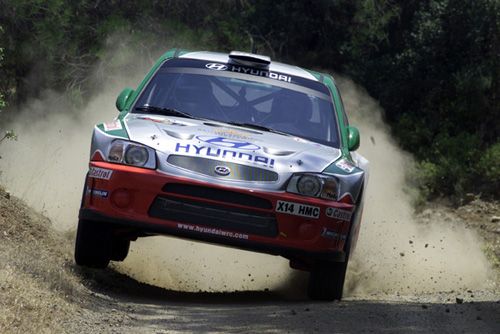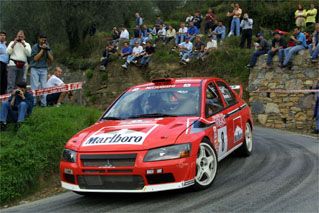Burns out early on.
Round eleven of the 2001 World Rally Championship started from the Italian coastal town of Sanremo last night, when all 73 competitors crossed the ramp at a starting ceremony close to the town's old Port.
Today saw the first day of competition, and crews left Sanremo at 0600hrs to travel east along the Mediterranean coast to the central service area in the town of Imperia. From there, they drove north to contest eight asphalt stages in the Ligurian hills.

Round eleven of the 2001 World Rally Championship started from the Italian coastal town of Sanremo last night, when all 73 competitors crossed the ramp at a starting ceremony close to the town's old Port.
Today saw the first day of competition, and crews left Sanremo at 0600hrs to travel east along the Mediterranean coast to the central service area in the town of Imperia. From there, they drove north to contest eight asphalt stages in the Ligurian hills.
Crews had to deal with a mixture of narrow and twisty tarmac stages, with climbs and descents on roads that featured a variety of grades of asphalt ranging from sections of old and abrasive road to newer smoother sections. Weather conditions were dry, with clear skies in the morning, and mist shrouding some of the higher stages in the afternoon.
Sanremo's race-track like stages attract the best specialist asphalt drivers in the world, and today's leg saw strong performances from rallying's smooth surface experts like Philippe Bugalski, Jesus Puras and Gilles Panizzi. This driving pedigree, combined with the experience of years of French tarmac championship competition for Peugeot and Citroen, kept the French teams on top with most of the WRC all-rounders further down the order.
The first stage of the day proved the most dramatic in terms of retirements - Richard Burns' Subaru left the road after 4kms, Armin Schwarz's Skoda retired with mechanical problems and Piero Liatti crashed out in a Hyundai. In the overall standings, Citroen's Jesus Puras held the overnight lead, closely pursued by the Peugeot of Gilles Panizzi in second place. Peugeots and Citroens hold the rest of the top six places, while the Subarus of Petter Solberg and Markko Martin are 10th and 11th.
Compared with the relative calm of last month's New Zealand rally, where no works cars retired during the event, the first stage in Italy provided plenty of drama. The first casualty of the tricky asphalt stages was the Subaru of world title contender Richard Burns - his Impreza slid wide on a corner 4kms from the start and stopped on a slope 2 metres below the stage. He was unable to get the car back onto the road, and was forced into retirement.
Burns said: "I don't really know what happened, it all went very quickly. We were 4kms in when I slid a bit too much in one corner, there was not enough room on the road, and halfway through we just lost the grip. We weren't pushing hard, the pace notes were correct, we just slid off, and the car went two or three metres down off the road. There was no way to get it back on. At the moment I just hope that we can do better in Corsica, and that Tommi and Colin don't pick up too many points here."
The stage also saw retirements from Skoda's Armin Schwarz (alterntor failure) and Hyundai's Piero Liatti who crashed 1km before the finish line. Peugeot's asphalt expert Gilles Panizzi won the stage, with teammate Marcus Gronholm behind him in second. Ford's Carlos Sainz was third and Citroen's Jesus Puras fourth. Tarmac ace Philippe Bugalski failed to live up to his reputation on the opening stage - he lost about 25 seconds when his Citroen hit a wall. Advised of Burn's retirement on the start line, Subaru driver Petter Solberg took things steady on the stage, but still finished within the top-10.
Sanremo is a favourite event for French drivers and manufacturers in the WRC, and on SS2 Citroen and Peugeot dominated the action. Between them, the two teams held the seven fastest times through the stage.
Jesus Puras took the win for Citroen, and moved into the overall lead of the rally. Philippe Bugalski recovered well after his collision with the wall on SS1, and was second quickest. Sebastien Loeb was fifth in an impressive 4WD Citroen debut, the Frenchman more used to driving the leading Saxo in the Super1600 category. Carlos Sainz was eighth and became the quickest non-French entry, Markko Martin was ninth and Petter Solberg 10th for Subaru. Meanwhile Tommi Makinen and Freddy Loix were both experiencing electronic differential problems with their new WRC specification Mitsubishi Lancers. The pair were well down the overall leaderboard in 15th and 23rd places respectively.
This stage was originally scheduled to be run together with SS2, but a route problem meant that it became a stage in it's own right. After a Citroen 1,2 on the previous stage this time it was Peugeot that took the honours, with Panizzi, Gronholm and Auriol making it a 1,2,3.
Bugalski and Puras were close behind in fourth and fifth places. Markko Martin was the lead Subaru driver in 10th place. The overall leaderboard was still tight at the top, Puras held the lead by less than two seconds from Panizzi, with Gronholm, Auriol and Sainz rounding off the top five. After the stage crews made their way back to the central service point at Imperia.
Spanish asphalt expert Jesus Puras took his second stage win of the day for Citroen in SS3 and extended his lead of the event by two seconds. Once again, the French manufacturers performed strongly on the stage and held the top five stage times. The closest competition this time came from a hard-charging Petter Solberg who beat current world champion Marcus Gronholm to take sixth place. Markko Martin was just behind him in eighth. Colin McRae was thirteenth through the stage - his Ford suffering with an intermittent differential problem that locked the front wheels in tight corners.
After it almost went terribly wrong for Bugalski on SS1 the Frenchman was quickest on SS4, making up lost time and moving up the leaderboard to fifth overall. Gronholm was second quickest, with Panizzi third. Jesus Puras could only manage seventh fastest, and lost the overall lead to Panizzi - although the two were only separated by 0.5 seconds. Sebastien Loeb was fourth with Auriol fifth. The performances of the asphalt specialists kept many of the more familiar WRC top-runners out of the limelight. In the overall standings Toshi Arai was 22nd, Freddy Loix 21st, Alister McRae 19th, Harri Rovanpera 16th, Makinen 15th and Colin McRae 13th. Petter Solberg and Markko Martin however continued to impress, and held ninth and 10th respectively.
The first of the final group of three repeated stages - SS5 - saw a second consecutive stage win for Bugalski. This helped his recovery and elevated him from fifth to fourth overall. Didier Auriol dropped back to fifth. While Panizzi was second, and extended his overall lead of the event to a slender 4.2 seconds. Petter Solberg was the sensation of the stage, he scorched through third fastest to become the only non-French entry in the top-six.
Jesus Puras broke Bugalski's run of fastest times in SS6, and had enough of an advantage to snatch the overall lead of the event from Panizzi. The overall leaderboard was now Citroen, Peugeot, Citroen, Peugeot, Peugeot, Citroen! Carlos Sainz was seventh, with the two Subaru young-guns Solberg and Martin setting exactly the same time to tie eighth. Alister McRae crashed his Hyundai and lost 10 minutes getting it back on the road. He dropped from 18th to 53rd.
Bugalski was quickest again in the final stage of the day (SS6b), and cut the time gap that separated him from second placed Panizzi to 16 seconds. Puras was second on the stage to hold the lead, with Panizzi third. Didier Auriol and Sebastien Loeb set exactly the same time to tie fourth - for Sebastien this was enough to gain another place on the leaderboard. He took Gronholm's place and moved up to fourth. Markko Martin spun his Subaru on a slippery 90-degree corner 10kms from the end. His car suffered light suspension damage, but he was able to continue. Markko and Petter Solberg had shared identical times on the previous stage - this time just 0.2 seconds separated them!
Reflecting on the day Petter Solberg, who is tenth overall said: "Today's been ok. We've had a couple of small problems, but are quite close to some of the best stage times. The car is under-steering a little, but it's not a big problem and we'll try to raise the pace a bit tomorrow. We changed the camber of the car for the final three stages this afternoon and noticed a big improvement."
His team-mate Markko Martin added: "We've been trying many different tyre options today, and have made a small mistake or two towards the end of the day, but I think we have some good knowledge of the tyres for tomorrow and hopefully we can push on a bit. I've enjoyed my driving today, and it's been good to have such close competition with Petter."
Toshi Arai continued: "It's been a difficult day - but overall not too bad. We tried some different suspension and roll bar settings, but these didn't work as well as I'd hoped. But that's what you have to do to get the best out of the car. Overall through it's been a good experience, and I'm looking forward to tomorrow."
Tomorrow's leg starts at 0600hrs when cars leave the overnight parc ferme at Sanremo and take a 39km drive long the Italian Riviera to the rally's central service point at Imperia. From there, they will contest eight stages in the hills to the north. Comprising 142 stage kms, Leg two is the longest of the event and features five repeated stages.
Technical Talk - Tyre treads and compounds:
With the exception of the Monte Carlo Rally, FIA regulations limit teams to just two tread patterns per WRC round. However, there is no limit to the number of compounds (the hardness of the tyre) that may be used.
In the case of a European WRC round, Manufacturer teams are required to nominate their two chosen tread patterns four weeks before the date of scrutineering. On all other rounds, they must give eight weeks notice.
In Sanremo the Subaru team's tyre partner, Pirelli, has brought almost 600 tyres for the four-car team. Engineers and drivers can choose from the following compounds:
* 3 dry weather PZero RS 'slick' tyre compounds
* 3 damp weather PZero RS 'slick' tyre compounds
* 3 intermediate PZero RE compound options
Although base tread patterns are limited, teams are allowed to 'cut' additional tread into them during the rally to help then cope with the prevailing conditions. For Subaru this work is done in the service area by skilled technicians from Pirelli's factory in Milan who hand carve the pattern using a heated blade.
Freedom to modify the base tread patterns gives teams a wide variety of compound and tread combinations. As an example, in the case of the Pirelli intermediate tyre, Subaru can choose from three compounds, and five tread 'cuts' that can transform the tyre from intermediate to a full wet specification.

